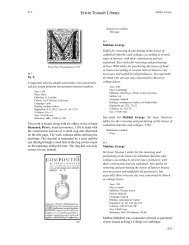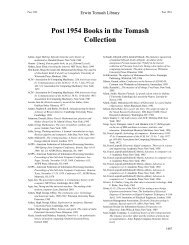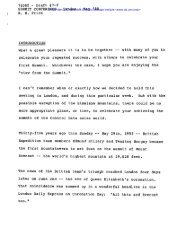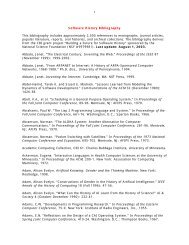B chapter.indd - Charles Babbage Institute - University of Minnesota
B chapter.indd - Charles Babbage Institute - University of Minnesota
B chapter.indd - Charles Babbage Institute - University of Minnesota
Create successful ePaper yourself
Turn your PDF publications into a flip-book with our unique Google optimized e-Paper software.
Erwin Tomash Library<br />
Bullet, Pierre Burkhardt, Heinrich Friedrich Karl Ludwig<br />
B 288<br />
Bullet, Pierre (1639–1716)<br />
Traite de l’usage du pantometre, instrument<br />
geometrique, propre à prendre toutes sortes d’angles,<br />
mezurer les distances accessibles & inaccessibles,<br />
arpenter & diviser toutes sortes de figures, & c.<br />
Year: 1675<br />
Place: Paris<br />
Publisher: André Pralard<br />
Edition: 1st<br />
Language: French<br />
Figures: engraved half title; woodcut device on title; woodcut<br />
initials and headpieces; engraved coat <strong>of</strong> arms printed<br />
on verso <strong>of</strong> title; 25 full-page engraved illustrations<br />
printed in text.<br />
Binding: contemporary sprinkled leather; gilt spine with raised<br />
bands<br />
Pagination: pp. [xxii], 26,187, [5]<br />
Collation: a 8 e 4 i 8 o 4 AB–PQ 8,4<br />
Size: 157x185 mm<br />
Pierre Bullet was a prominent architect and engineer. He<br />
was responsible for a number <strong>of</strong> works in Paris, including<br />
the rebuilding <strong>of</strong> the Quay le Peletier in 1673. In 1676,<br />
he published, with Nicolas-François Blondel, a plan <strong>of</strong><br />
Paris showing all <strong>of</strong> its buildings.<br />
It seems likely that during his survey <strong>of</strong> Paris, Bullet<br />
created the pantometre instrument described in this<br />
work. It was not unlike many such devices <strong>of</strong> its day—<br />
basically three rods hinged together or, like this one,<br />
one rod capable <strong>of</strong> sliding on another (see entries for<br />
Pantometre, B 288<br />
Danfree, 1597, and Bürgi, 1684). Bullet indicates that<br />
this version could be purchased from the stock <strong>of</strong> the<br />
instrument maker Lemaire in Paris. The work is well<br />
illustrated, showing the instrument in use for the usual<br />
types <strong>of</strong> problems: finding heights <strong>of</strong> towers, depths <strong>of</strong><br />
wells, breadths <strong>of</strong> rivers, etc.<br />
The unusual collation results from the original printed<br />
sheets having been cut in two unequal portions that were<br />
separately signed before being bound.<br />
Illustrations available:<br />
Title page<br />
Pantometre instrument<br />
Instrument in use<br />
[Burgi, Joost (1552–1632)]<br />
See Bramer, Benjamin; Dritter Theil oder Anhang<br />
eines Berichts von M. Johsten Burgi, 1684.<br />
Journal cover, B 289<br />
B 289<br />
Burkhardt, Heinrich Friedrich Karl Ludwig (1861–<br />
1914)<br />
Wie man vor Zeiten rechnete<br />
Year: 1905<br />
Place: Leipzig<br />
Publisher: B. G. Teubner<br />
Edition: <strong>of</strong>fprint<br />
Language: German<br />
Binding: original paper wrappers<br />
Pagination: pp. 9–20<br />
Size: 247x162 mm<br />
Burkhardt was a major figure in the manufacture<br />
<strong>of</strong> mechanical calculating machines. His factory in<br />
225







